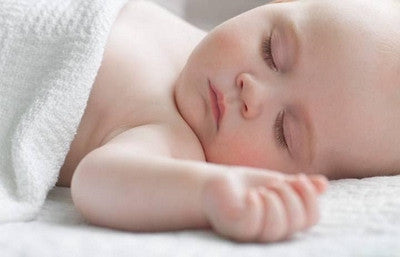Make sure your children’s sleep space is “clean room” safe; buy an organic mattress.
Expecting a child? Nurturing a newborn? Then you know that healthy sleep is part of the formula for growing up strong. While at rest, babies’ bodies are actually hard at work building and refining the mental capacity and organ functions that will carry them through life.
Where babies lay their heads is of profound importance to their health and well-being. The unseen compounds that they absorb through their tender skin and breathe in from the air can either aid or block their growth. Because kids spend 40 percent of their early years sleeping, bedroom environments have a huge impact on the developmental process.
Imagine your child’s bedroom like a computer-chip laboratory that must control air quality. The lower the contamination, the better the product. Growing bodies also thrive in such environments. So keep yours clean! You can create a “clean room” by choosing an organic child’s bed that doesn’t add unwanted chemicals to the mix.
The Immediate Health Concerns
Developing bodies are more vulnerable than mature ones to infection, respiratory disease, and immune and nervous system damage. Some of the factors that cause these problems may also be linked to SIDS, or sudden infant death syndrome. This fatal condition is still not fully understood by researchers and remains a primary fear of loving parents. So, why is a crib or toddler’s bed so important? All of these health threats have been linked to the materials in conventional crib or cot mattresses.
Many regular mattresses are made of polyurethane foam and synthetic fabric or plastic and treated with chemical flame retardants. While none of this stuff is good for adults, it is worse for infants and children. Compounds that restrict breathing or trigger allergic reactions may lead to asthma or frequent respiratory illness. Those that affect the immune system increase the risk for contagious disease and even SIDS.
The U.S. Consumer Product Safety Commission allows or demands the use of some materials to meet mattress standards. While certain compounds known to cause cancer have been banned—such as some bromines, for instance—others have not. Regulatory commissions accept a safety trade-off because testing shows that humans can withstand certain levels of toxicity.
But how much is too much for your child? Your baby may be dealing with health issues already. Or you may just want to provide the best start possible. To find out how to minimize bedroom contaminants, take a look at what you might find in an ordinary crib mattress.
Dirty Secrets Hide in Regular Mattresses
Polyurethane foam is known to emit compounds that are volatile on their own or become so when they contact other airborne gasses. Substances such as acetone, methyl benzene, and napthalene affect breathing, immune system function, and nervous system development.
Polyurethane also degrades with use, sending particulate into the air and opening up space within mattresses. These crevices are invaded by allergenic dust mites, to which babies are sensitive. When combined with a cover that is not breathable, polyurethane traps the heat and humidity from babies’ bodies and creates perfect living conditions for these insects.
A 2007 study conducted by British researchers also found that crib mattresses made of polyurethane foam harbor harmful bacterial growth, including staphylococcus and bordatella pertussis. Scientists in 2005 found consistent bacterial levels in foam and polyester-covered mattresses that may be linked with SIDS and breathing problems.
Polyvinyl plastic and polyester wrapping trap the heat and humidity that polyurethane foam cores attract from sleeping babies. This “perfect storm” perpetuates bacterial and allergenic threats to environmental quality. But consider the materials that are added to these, which represent deeper, darker secrets.
Fire retardants, pesticide-treated fabrics, and manufacturing adhesives infuse mattress surfaces and the air babies breathe with potentially harmful chemicals. These may include:
- antimony oxide
- boric acid
- bromine
- chlorinated tris (TDCPP)
- formaldehyde
The good news is: you have a choice. Opt for a baby crib mattress made without toxic glues, chemical coatings, synthetic fabric, or conventionally grown plant fibers treated with pesticides and fertilizers. It’s called an organic mattress.
How Organic Mattresses Promote Clean Sleep
Health care professionals agree on the mattress qualities that promote safe and clean sleep for babies. The National Institute of Child Health suggests a firm surface that regulates heat, to reduce SIDS risk. The American Lung Association recommends minimizing particulates and chemical gasses in the air, to avoid pertussis, a serious respiratory disease that can be fatal in infants.
An organic mattress does what’s needed—without adding dangerous toxins to the air. Be sure to research products and go organic. Those labeled “natural” may still be tainted with pesticides and fire proofing. And understand that no testing commission pronounces a mattress organic, but its components can certainly be certified.
For the best air quality in your child’s bedroom, choose a mattress that layers an organic latex core with organic wool padding and an organic cotton cover. You’ll solve all those problems brought on by the breakdown and interaction of synthetics with the indoor atmosphere. And you’ll provide a firm, breathable surface that is soft on babies’ skin and conducive to hours and hours of good, clean sleep.
